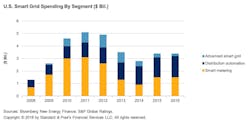Blockchain and Other Double-Edged Issues Confronting Utilities’ Future
Every modernization decision and technology path chosen by electric utilities has the potential to start companies down a long-term path for success or failure. In a recent report entitled “Grid Modernization: What Will Blockchain Technology Mean For U.S.-Regulated Electric Utilities? ”, S&P Global Ratings reveals its view that blockchain technology, like practically any new technology, has the potential to help utilities or hurt them. Other aspects of this insightful report are also notable.
Standard and Poor’s Financial Services, LLC is one of a number of companies that investigates issues that could affect regulated utilities' credit quality. In the article cited here, S&P Global Ratings points out that utility infrastructure is aging and requires modernization. Utilities are spending billions to make smart grid investments to improve reliability, resiliency, efficiency and flexibility (see graphic). Spending on smart meters, distribution automation and advanced smart grid technologies have been leading choices. These types of investments are viewed as relatively low risk from a utility credit point of view because they support rate base growth or customer satisfaction.
Blockchain is an example of a leading technology that could lead to advancements for utilities or have negative impacts on the financial ratings of companies depending upon how it is used. Blockchain is the technology behind cryptocurrencies and potentially many other uses such as smart contracts, financial market transactions, retail applications and energy trading. The value we have frequently focused on from a utility prospective is that the technology is energy intensive and would likely be very attractive load, similar to data centers. The aspect less covered is that blockchain technology could be used by utilities for transactions that involve risk to the utility; i.e.; risk of financial losses. Energy arbitrage is one example. Conversely, utilities could embrace blockchain technology to improve transparency in such areas as renewable energy credit (REC) or demand response validation.
The future is not cast on blockchain technology, but this article effectively points out that new technologies can be an enabler or a disrupter for utilities and therefore managers need to weigh how adoption decisions will affect their credit rating, which is another way of saying their financial stability or attractiveness to investors.
About the Author
David Shadle
Grid Optimization Editor
Dave joined the T&D World team as the editor of the Grid Optimization Center of Excellence website in January 2016.
Dave is a power industry veteran with a history of leading environmental and development organizations, championing crucial projects, managing major acquisitions and implementing change. Dave is currently a principal at Power Advance, LLC, an independent consulting firm specializing in power project development, research and analysis, due diligence and valuation support. Dave is also a contributing consultant for Transmission & Distribution World. Prior to Power Advance, Dave held business and power project development positions with The Louis Berger Group, Iberdrola Renewables, FPL Energy and General Public Utilities. He is a graduate of Pennsylvania State University, the New Jersey Institute of Technology and Purdue University.

